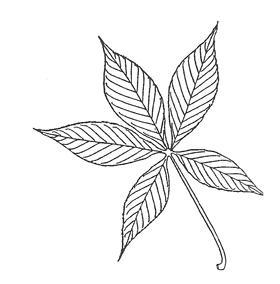Aesculus glabra (es’-ku-lus glae’-bra)
Family: Sapindaceae, Soapberry
Key Steps
- 1a – Opposite leaf arrangement on stem — go to 2
- 2b – Leaf compound — go to 14
Description
 Leaf: Usually 5 (rarely 7) leaflets, finely toothed. Broadest at the middle, tapering to points at both ends. Petiolules (leaflet stalks) are pinched, short. Leaflets 3-6 inches long. Leaf smells bad when crushed.
Leaf: Usually 5 (rarely 7) leaflets, finely toothed. Broadest at the middle, tapering to points at both ends. Petiolules (leaflet stalks) are pinched, short. Leaflets 3-6 inches long. Leaf smells bad when crushed.
Bud: Terminal bud is light brown, not sticky, large (1/2 inch or longer) and oval. Lateral buds are smaller. Bud scales have a central ridge and may have a hairy margin.
Leaf Scar: Large, shield-shaped or triagular. 5-7 bundle scars in 3 groups.
Stem: Stout (1/4 inch thick or more). Stems smell bad when crushed.
Pith: May be six-sided, large, continuous, pale.
Bark: Gray. Vertical ridges and plates.
Flowers: Large 4-7 inch long yellow panicle in May. Bell-shaped blossoms. Smells bad.
Fruit: Slightly prickly ball, solitary. Similar to but not as prickly as Horsechestnut.
Habit: Medium size, dense, shade tree. Round canopy. 40 feet tall.
Culture: Moderate moisture requirements. Needs lots of room to spread. Well-drained soils.
Note: Seeds, young stems and leaves of Buckeye may be toxic to livestock.
Resources




